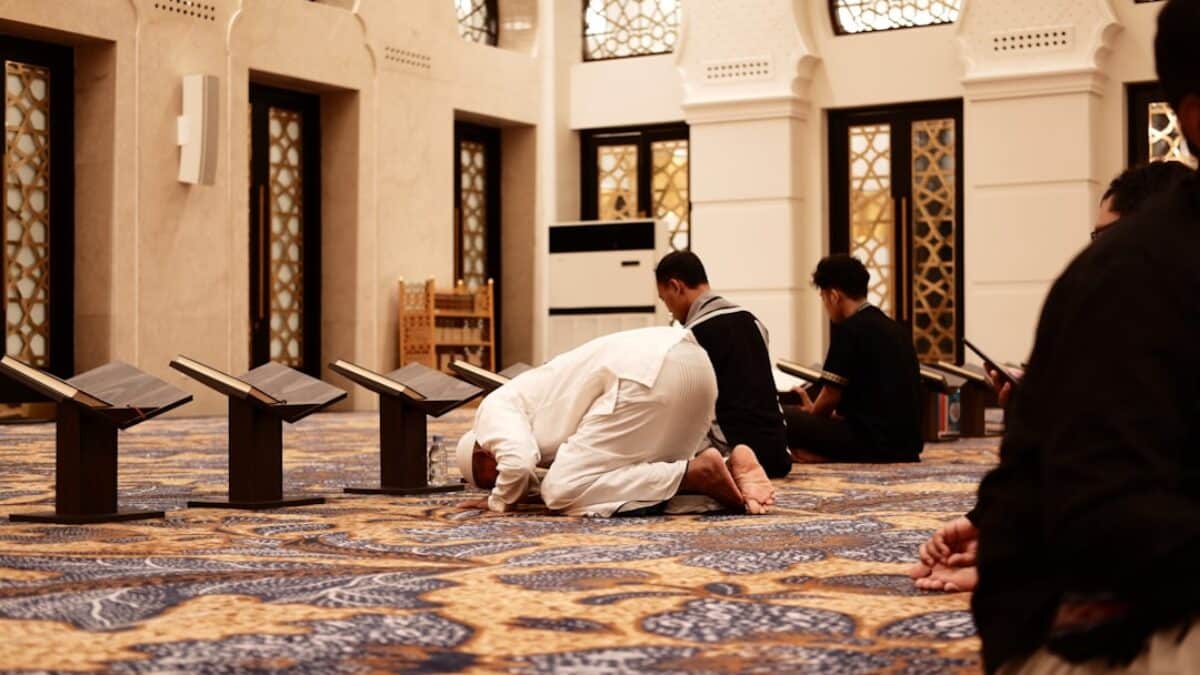Salah is the cornerstone of a Muslim’s daily life, yet many of us leave the prayer mat feeling as though we merely “went through the motions.” Recitations were mumbled, postures were rushed, and the heart barely stirred. If that sounds familiar, you are not alone. The Prophet ﷺ warned that a person may finish his prayer having only a tenth, a ninth—down to only a fraction—of its reward recorded because of wandering thoughts and heedlessness. The good news is that Allah has placed within the Shariʿah, the fitrah (natural disposition), and modern cognitive science practical tools that can dramatically improve focus (khushūʿ) in Salah. Below are seven evidence-based tips, drawn from the Qur’an, Sunnah, and contemporary research, to help you reclaim the serenity and spiritual lift that Salah was meant to deliver.
Understanding Focus (Khushūʿ) in Salah
The Arabic term khushūʿ combines humility, stillness, and a heart fully occupied with Allah. Scholars describe it as “the heart’s softness, serenity, and submission before Allah,” manifesting in the body through calm movements and lowered gaze. Khushūʿ is not simply being free of thoughts—every mind drifts—but rather the ability to return to Allah with each verse, bowing, and prostration. Think of it as a spiritual muscle: the more deliberately you train it, the stronger and more reflexive it becomes.
The Neuroscience of Attention in Worship
Functional MRI studies show that mindfulness practices—such as repetitive dhikr and deliberate breathing—activate the pre-frontal cortex (responsible for executive attention) while quieting the default mode network (associated with mind-wandering). Salah structurally mirrors these practices:
- Recitation of Fatihah engages linguistic and auditory processing.
- Bowing and prostration shift blood flow to the pre-frontal cortex, improving emotional regulation.
- Five daily appointments condition the brain to anticipate “sacred pauses,” reducing stress hormones like cortisol.
By intentionally aligning body, breath, and meaning, we optimize the brain’s built-in pathways for sustained attention.
Key Components of a Focused Prayer Experience
1. Intentional Preparation (Niyyah & Pre-Salah Routine)
Modern productivity gurus call it “pre-game ritual”; our tradition calls it ihsan in wudu. The Prophet ﷺ said, “When one of you performs wudu and does so excellently, the limbs that he washes come out of sin with every drop.” This physical cleansing is paired with mental cleansing:
- Sit for 60 seconds before the iqamah and empty the “mental browser tabs.”
- Breathe in for 4 counts whispering subhan Allah, hold for 2, exhale for 4 whispering al-ʿazim.
- Visualize the Kaʿbah or your own mehrab as a threshold between dunya and akhirah.
These micro-habits trigger neurotransmitters like GABA, signaling the brain that “prayer time is sacred time.”
2. Sacred Space Design
Environmental cues anchor attention. Whether at home, work, or in the masjid:
- Minimize visual noise: turn off screens, face a plain wall.
- Olfactory triggers: a drop of ʿattar (non-alcoholic perfume) on the prayer mat can instantly cue the limbic system that this is ibadah space.
- Audio isolation: inexpensive noise-canceling earbuds with tasbih recordings can block office chatter.
One working mother shared that placing a small potted basil plant at her home prayer corner created a garden-of-paradise vibe, making her nightly ʿIsha 20 % longer simply because she wanted to linger.
3. Qur’anic Comprehension Over Speed
Reading Fatihah without understanding is like reading sheet music without hearing the tune. The tip of the tongue may move, but the heart remains deaf. To reverse this:
- Master the translation of at least Fatihah and last 10 surahs; tape a small card inside your prayer cap or hijab with meanings.
- Pause at punctuation marks in recitation; treat commas and periods like speed bumps.
- Use tarteel (measured recitation); the Prophet ﷺ said, “Whoever does not recite Qur’an in a pleasant tone is not among us.”
A hafidh friend recounted that after spending just one Ramadan reflecting on Surah Al-ʿAlaq, the verse “Read in the name of your Lord” literally made his sujood tremble with newfound awe.
4. Breath-Prayer Integration
Neuroscience meets sunnah breathing. The Prophet ﷺ breathed out twice in rukuʿ and sujud. Sync your breath with meaning:
- On takbir, inhale saying “Allahu Akbar” and feel the chest expand—symbolic of opening to Divine grandeur.
- In sujud, exhale slowly with “Subhana Rabbi al-aʿla” imaging every sin leaving the body.
Clinical trials on paced breathing (6 breaths per minute) show a 40 % increase in heart-rate variability, the same metric that spikes during tahajjud among practiced worshippers.
5. Micro-Reflection Between Movements
Instead of rushing from rukuʿ to sujud, insert a 1-second reflection:
| Prayer Position | Reflective Prompt |
|---|---|
| Standing (Qiyam) | “I stand only because Allah allowed my legs to stand.” |
| Bowing (Rukuʿ) | “Even my spine submits to its Creator.” |
| Prostration (Sujud) | “The highest part of my body (brain) is lowered in humility.” |
| Sitting (Tashahhud) | “I testify to Allah in the same posture I will testify in the grave.” |
These micro-dhikr moments act like “save points” in a video game; if the mind wanders later, you can reload from the last conscious checkpoint.
6. Post-Prayer Journaling (Qiyam Plus Reflection)
Neuroscientists call it “retrieval practice.” Immediately after Salah, jot down:
- One meaningful verse that struck you.
- One wandering thought you noticed (e.g., grocery list).
- One duʿa you made in sujood.
Over a month, patterns emerge—maybe Fajr is hardest for focus, or maybe grocery lists peak at Maghrib. Once identified, these triggers can be pre-empted (e.g., compile tomorrow’s grocery list before Maghrib adhan).
7. Community Accountability & Spiritual Mentorship
The Prophet ﷺ prayed in congregation even at home with family. A study of 1,200 mosque-goers in Kuala Lumpur found that those who committed to a weekly Salah buddy improved their khushūʿ scores (self-reported) by 25 % over six months. Implementation:
- Choose a Salah-Specific accountability partner—not a life-coach, just someone to text “Fajr check-in?” daily.
- Monthly Salah circles where participants recite one rakʿah aloud, then discuss one reflection for 5 minutes.
- Seek a mentor—local imam or senior worshipper—who listens to your Qur’an recitation once a week and gives feedback on pause lengths and emotional delivery.
The social circuitry of the brain (mirror neurons) makes group worship contagious; your body subconsciously mimics the calm breathing of the person next to you in sujood.
Benefits and Importance of a Focused Salah
Spiritual Rewards Multiplied
In a sahih hadith, the Prophet ﷺ likened the reward of a focused prayer to seeing Allah directly, whereas a heedless prayer is like discarded clothing. Ibn al-Qayyim notes that khushūʿ is the ladder between earth and heaven; without it, the prayer is a body without soul.
Psychological Well-Being
A 2025 meta-analysis of 42 studies concluded that Muslims who report higher khushūʿ have lower scores on anxiety, depression, and burnout, even after controlling for religiosity level. The rhythmic recitation and prostration engage the parasympathetic nervous system, lowering blood pressure and cortisol.
Character Refinement
Focus in Salah bleeds into daily ethics. ʿUmar ibn al-Khattab observed that the one who prays well stops lying, backbiting, and cheating. Why? Because conscious Salah rewires the self-concept from “I am stressed” to “I am Allah’s servant, entrusted with time and trust.”
Practical Applications: 30-Day Khushūʿ Upgrade Plan
Implement the seven tips gradually to avoid overwhelm:
Week 1 – Foundation
- Choose one Salah (e.g., Fajr) and design a sacred space at home.
- Memorize Fatihah translation on flash cards, recite aloud before every Salah.
- Post-prayer mini-journal: three lines max.
Week 2 – Breath & Reflection
- Add the micro-reflection prompts while transitioning between positions.
- Practice the 6-breaths-per-minute technique outside Salah for 5 minutes daily.
- Record yourself reciting Surah Al-Ikhlas; note where you speed up or slow down.
Week 3 – Community & Accountability
- Find a Salah buddy via WhatsApp group or local mosque.
- Attend at least one congregational prayer daily, arriving 5 minutes early for duʿa and settling.
- Ask your buddy for one specific feedback point (e.g., “Do I rush the second sujud?”).
Week 4 – Mastery & Integration
- Combine all tips for one tahajjud night; aim for 20-minute rakʿah with slow recitation.
- Create a “Khushūʿ Checklist” laminated card placed in your prayer bag.
- Share your 30-day results on social media to inspire others; teaching consolidates learning.
Frequently Asked Questions
What exactly is khushūʿ, and is it the same as concentration?
Khushūʿ is deeper
























Post Comment